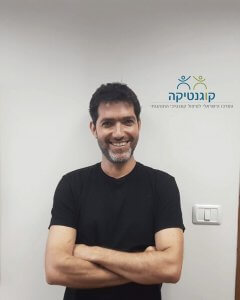פרופסור גיא דורון הוא פסיכולוג קליני ומרצה בכיר במרכז הבינתחומי הרצליה. פרופ' דורון הינו בוגר לימודי פסיכולוגיה קלינית ו- PhD באוניברסיטת מלבורן באוסטרליה, פרסם מעל 50 פרסומים בכתבי עת מדעיים/ספרים וזכה במספר מענקי מחקר תחרותיים מהאיחוד האירופאי והמדען הראשי. ניסיונו הטיפולי כולל עבודה בבתי חולים, מרפאות פתוחות ומכוני מחקר להפרעות פסיכיאטריות. פרופ' דורון הינו אחד החוקרים המובילים בעולם להפרעה טורדנית כפייתית ביחסים (ROCD) ובשיתוף עם ד"ר דני דרבי, הקים ומנהל את היחידה למחקר וטיפול בהפרעה טורדנית ביחסים ((ROCD-RU; ROCD.net. פרופ' דורון גם מעורב בפיתוח טכנולוגיות ועזרי טיפול למטפלים ולמטופלים.
פרסומים אקדמיים
- Milfont, T.L, Bain, P., Kashima, Y. et al., (in press). The influence of social dominance orientation on environmentalism: A 25-nation study. Social Psychological and Personality Science.
- Roncero, M., Belloch, A., & Doron, G. (2018). A novel approach of challenging OCD related beliefs using a mobile-app: An exploratory study. Journal of Behavior Therapy and Experimental Psychiatry, 59, 157-160.
- Aerdema, F., Moulding, R., Melli, G., Radomsky, A., Doron, G., Audet, J., & Lalonde. M. (2018). The role of feared possible selves in obsessive compulsive and related disorders: A comparative analysis if a core cognitive construct in clinical samples. Clinical Psychology and Psychotherapy, 25, e19-e26.
- Doron, G., Derby, D., & Szepsenwol. O. (2017). “I can’t stop thinking about my child’s flaws”: An investigation of parental preoccupation with their children’s perceived flaws. Journal of Obsessive-Compulsive and Related Disorders, 14, 106-111. doi: 10.1016/j.jocrd.2017.06.007
- Szepsenwol. O., Shachar, B., & Doron, G. (2016). Letting it linger: Exploring the longitudinal effects of relationship-related obsessive-compulsive phenomena. Journal of Obsessive-Compulsive and Related Disorders, 11, 101-104.
- Derby, D., Peleg-Sagy. T., & Doron, D. (2016). Schema therapy in Sex Therapy: A theoretical conceptualization. Journal of Sex & Marital Therapy, 42, 648-658.
- Ein-Dor, T., Viglin, D., & Doron, G. (2016). Extending the transdiagnostic model of attachment and psychopathology. Frontiers Psychology,7, 484.
- Doron, G., Derby, D. S., Szepsenwol, O., Nahaloni, E., & Moulding, M. (2016). Relationship Obsessive Compulsive Disorder (ROCD): Interference, symptoms and maladaptive beliefs. Frontiers in Psychiatry, 7, 58.
- Bain, P. G., Milfont, T. L., Kashima, Y., Bilewicz. M., Doron.G., et al., (2016). Co-benefits of addressing climate change can motivate action around the world. Nature Climate Change, 6, 154-157.
- Saguy, T., Szekeres. H, Nuri, R., Goldenberg, A. Doron, G., Dovidio.J.F. & Halperin. E. (2015). Awareness of Intergroup Help Can Rehumanize the Outgroup. Social Psychological and Personality Science, 6, 551-558.
- Doron, G., & Szepsenwol. O. (2015). Partner-focused obsessions and self-esteem: An experimental investigation. Journal of Behavior Therapy and Experimental Psychiatry, 49, 173-179.
- Shahar, B., Doron, G., & Szepsenwol, O. (2015). Childhood maltreatment, shame-proneness, and self-criticism in social anxiety disorder: A sequential mediational model. Clinical Psychology & Psychotherapy, 22, 570-579.
- Radomsky, A. S., Alcolado, M. G., et al., (2014). Part 1. You can run but you can’t hide: Intrusive thoughts on six continents. Journal of Obsessive-Compulsive and Related Disorders, 3, 269-279.
- Moulding, R., Coles, M., et al., (2014). Part 2. They scare because we care: The relationship between obsessive intrusive thoughts and appraisals and control strategies across 15 cities. Journal of Obsessive-Compulsive and Related Disorders., 3, 280-291.
- Clark, D. A., Abramowitz, J., et al., (2014). Part 3. A Question of Perspective: The Association between Intrusive Thoughts and Obsessionality in 11 Countries. Journal of Obsessive-Compulsive and Related Disorders., 3, 292-299.
- Doron, G., Derby, D., & Szepsenwol. O. (2014). Relationship obsessive compulsive disorder (ROCD): A conceptual framework. Journal of Obsessive-Compulsive and Related Disorders, 3, 169-180.
- Doron, G., (2014). Introduction: Obsessional Content, Phenomenology, Etiology, and Maintenance. Journal of Obsessive-Compulsive and Related Disorders, 3, 139.
- Doron, G., Mizrahi, M., Szepsenwol, O., & Derby, D. (2014). Right or Flawed: Relationships Obsessions and Sexual Satisfaction. Journal of Sexual Medicine, 11, 2218-2224.
- Sar-El, D., Mikulincer, M., & Doron, G. (2013). Attachment orientations and individual differences in humor. Journal of Social and Clinical Psychology, 32, 34-53.
- Doron, G., Szepsenwol. O., Karp. E., & Gal. N. (2013). Obsessing About Intimate-Relationships: Testing the Double Relationship-Vulnerability Hypothesis. Journal of Behavior Therapy and Experimental Psychiatry, 44, 433-440.
- Aardema, F. Moulding, R. Radomsky, A. S, Doron, G. Allamby, J. (2013). Fear of Self and Obsessionality: Development and Validation of the Fear of Self Questionnaire. Journal of Obsessive- Compulsive and Related Disorders, 3, 306-315.
- Doron, G., Szepsenwol, O., Elad-Strenger, J., Hargil, E., & Bogoslavsky., B. (2013). Entity Perceptions of Morality and Character are Associated with Obsessive Compulsive Phenomena. Journal of Social and Clinical Psychology, 32, 733-752.
- Abramovitch, A., Doron, G., Sar-El, D., Altenburger. E. (2013). Subtle threats to moral self-perceptions trigger obsessive-compulsive related cognitions. Cognitive Therapy and Research, 37, 1132-1139 .
- Doron, G., Derby, D., Szepsenwol. O., & Talmor. D. (2012). Tainted Love: exploring relationship-centered obsessive compulsive symptoms in two non-clinical cohorts. Journal of Obsessive-Compulsive and Related Disorders,1, 16-24.
- Doron, G; Sar-El, D. Mikulincer, M. (2012). Threats to Moral Self-perceptions trigger obsessive compulsive contamination-related behavioral tendencies. Journal of Behavior Therapy and Experimental Psychiatry, 43, 884-890.
- Doron, G., Talmor, D., Szepsenwol, O., & Derby, S. D. (2012). Relationship-centered obsessive compulsive symptoms, Psicoterapia cognitiva e comportamentale,18, 79-90.
- Doron, G; Moulding, R., Nedeljkovic, M., Kyrios, M., Mikulincer. M., & Sar-El. (2012). Adult attachment insecurities are associated with obsessive compulsive disorder. Psychology and Psychotherapy: Theory, Research and Practice, 85, 163–178.
- Doron, G., Derby, D., Szepsenwol. O., & Talmor. D. (2012). Flaws and All: Exploring Partner-Focused Obsessive-Compulsive Symptoms. Journal of Obsessive-Compulsive and Related Disorders, 1, 234-243.
- Doron, G., Szepsenwol, O., Derby, D., & Nahaloni, E. (2012). Relationship-related obsessive-compulsive phenomena: The case of relationship-centered and partner-focused obsessive compulsive symptoms. Psicoterapia Cognitiva e Comportamentale, 18.
- Doron, G; Sar-El, D. Mikulincer, M., & Talmor, D. (2012). Experimentally-enhanced attachment security influences obsessive compulsive related washing tendencies in a non-clinical sample. E-Journal of Applied Psychology, 8, 1-8.
- Steinmetz, S., Kaczmirek, L., de Pedraza, P., Reips, U. D., Tijdens, K., Lozar Manfreda, K., et al.,. (2012). WEBDATANET: A Network on Web-Based Data Collection, Methodological Challenges, Solutions and Implementation. International Journal of Internet Science, 7, 78-90.
- Nedeljkovic, M., Kyrios, M., Moulding, R., & Doron, G. (2011). Neuropsychological predictors of symptom change in patients with Obsessive Compulsive Disorder following cognitive-behavioural therapy. International Journal of Cognitive Therapy, 4, 8-20.
- Moulding, R., Anglim, J., Nedeljkovic, M., Doron, G., Kyrios, M., & Ayalon, A. (2011). The Obsessive Beliefs Questionnaire (OBQ):Examination in non-clinical samples and development of a short version, Assessment, 18, 357-374.
- Guttmann-Steinmetz, S. Crowell, J. A., Doron. G., & Mikulincer. M. (2011). Associations between mothers’ and children’s secure base scripts in ADHD and community cohorts. Attachment and Human Development, 13 (6), 597-610.
- Eindor, T., Mikulincer, M., Doron, G., & Shaver, P.(2010). The attachment paradox: How can so many of us (the insecure ones) have nothing but disadvantages? Perspectives on Psychological Science, 5, 123-141.
- Ein-dor, T., Doron, G., Solomon. Z, Mikulincer. M, & Shaver. P (2010). Together in pain: attachment-related dyadic processes and posttraumatic stress disorder. Journal of Counseling Psychology, 57, 317-327.
- Loughnan, Leidner, Doron, Haslam, Kashima, Tong, & Yeung (2010). Universal biases in self-perception: Better and more human than average. British Journal of Social Psychology, 49, 627-636.
- Doron, G., Moulding, R., Kyrios, M., Nedeljkovic, M., & Mikulincer (2009). Adult attachment insecurities are related to obsessive compulsive phenomena. Journal of Social and Clinical Psychology, 28, 1025-1052.
- Nedeljkovic, M., Moulding, R., Kyrios, M., & Doron, G. (2009). The relationship of cognitive confidence to OCD symptoms. Journal of Anxiety Disorders, 23,463-468.
- Moulding, R., Doron, G., Kyrios, M., & Nedeljkovic, M. (2009). Mediated and direct effects of control beliefs on obsessive compulsive symptoms. Canadian Journal of Behavioural Science, 41, 84-92.
- Nedeljkovic, M., Kyrios, M., Moulding, R., Doron, G., Wainwright, K., Pantelis, C., Purcell, R., & Maruff, P. (2009). Differences in neuropsychological performance between subtypes of Obsessive-Compulsive Disorder. Australian and New Zealand Journal of Psychiatry, 43, 216-226.
- Doron, G., & Moulding, R. (2009). Cognitive behavioral treatment of obsessive compulsive disorder: A broader framework. Israel Journal of Psychiatry and related sciences, 46, 257-264.
- Doron, G., Moulding, R., Kyrios, M., & Nedeljkovic, M. (2008). Sensitivity of self-beliefs in Obsessive Compulsive Disorder (OCD). Depression and Anxiety, 25, 874–884.
- Moulding, R., Doron, G., Kyrios, M., & Nedeljkovic, M. (2008). Desire for control, sense of control and obsessive-compulsive checking: An extension to a clinical sample. Journal of Anxiety Disorders, 22, 1472–1479.
- Doron, G., Kyrios, M., & Moulding, R. (2007). Sensitive domains of self-concept in Obsessive-Compulsive Disorder: Further evidence for a multidimensional model of OCD. Journal of Anxiety Disorders , 21, 433-444.
- Doron, G., Kyrios, M, Moulding, R., Nedeljkovic, M., & Bhar, S. (2007). “We do not see things as they are, we see them as we are”: A multidimensional world-view model of Obsessive Compulsive Disorder (OCD). Journal of Cognitive Psychotherapy, 23,221-235.
- Moulding, R., Kyrios, M., & Doron, G. (2007). Appraisals and obsessive-compulsive behaviours in specific situations: The relative influence of appraisals of control, responsibility and threat. Behaviour Research and Therapy, 45, 1693-1702.
- Moulding, R., Kyrios, M., Doron, G., & Nedeljkovic, M. (2007). Autogenous and reactive obsessions: A confirmatory factor analysis and examination of their relationship to obsessive compulsive symptoms and beliefs. Journal of Anxiety Disorders, 21, 677-690.
- Doron, G., & Kyrios, M. (2005). Obsessive Compulsive Disorder: A review of possible specific internal representations within a broader cognitive theory. Clinical Psychology Review, 25, 415-432.
Chapters in peer-reviewed books
- Doron, G., & Derby, D. (2017). Assessment and treatment of relationship-related OCD symptoms (ROCD): A modular approach. In J. S. Abramowitz, D. McKay, & E. A. Storch (Eds.), The Wiley handbook of obsessive-compulsive disorder across the lifespan. Hoboken, NJ: Wiley.
- Mikulincer, M., & Doron, G., (2016). Adult attachment and self-related processes. In Kyrios, M., Moulding, R., Doron, G., Bhar, S.S., Nedeljkovic, M. &Mikulincer, M. (Eds.) The self in understanding and treating psychological disorders (pp.19-28). Cambridge, UK: Cambridge University Pres.
- Kyrios, M., Moulding, R., Bhar, S.S., Doron, G., Nedeljkovic, M., & Mikulincer, M. (2016). Future directions in examining the self in psychological disorders. In Kyrios, M., Moulding, R., Doron, G., Bhar, S.S., Nedeljkovic, M. & Mikulincer, M. (Eds.) The self in understanding and treating psychological disorders (pp.233-236). Cambridge, UK: Cambridge University Press.
- Ein-Dor, T., & Doron, G. (2015). Attachment and Psychopathology. In J. A. Simpson & W. S. Rholes (Eds.), Attachment theory and research: New directions and emerging themes (pp.346-373). New York, NY: Guilford Press.
- Doron, G., Mikuincer, M., Sar-El, D., & Kyrios, M. (2015). Integrating psychodynamic and cognitive approaches to Obsessive Compulsive Disorder – attachment insecurities and self-related sensitivities in the morality and relational domains in P. Luyten, L. Mayes, P. Fonagy, M. Target, & S. J. Blatt (Eds); Handbook of Contemporary Psychodynamic Approaches to Psychopathology (pp 199-215). NY: Guilford Press.
- Doron, G., Sar-El., D., Mikulincer, M., & Kyrios, M. (2012). When Moral Concerns Become a Psychological Disorder: The Case of Obsessive Compulsive Disorder. In M. Mikulincer & P.R., Shaver (Eds.). Social Psychology of Morality: Exploring the Causes of Good and Evil (pp. 293—310). Washington, DC: American Psychological Association.
- Ben Harush, O., & Doron, G. (2011). Treatment of Adults with Obsessive Compulsive Disorder (OCD). In Marom & Gilboa-Schectman. Cognitive Behavioral Therapy for Adults: An integrative approach. Probook, Israel (in Hebrew.(
- Nedeljkovic, M., Moulding, R., Foroughi, E., Kyrios, M., & Doron, G. (2011). Cultural issues in understanding and treating obsessive compulsive and spectrum disorders. Invited Chapter for G. Steketee (Ed.). Oxford Handbook of Obsessive Compulsive and Spectrum Disorders (pp.469-520). UK: Oxford University Press.
- Kyrios, M., Nedeljkovic, M., Moulding, R., & Doron, G. (2007). Problems of employees with personality disorders: The exemplar of Obsessive-Compulsive Disorder. In J. Langan-Fox, C. Cooper., & R. Klimoski (Eds), Research Companion to the Dysfunctional Workplace: Management Challenges and Symptoms, New Horizons Management Series.
Books
59. Kyrios, M., Moulding, R., Doron, G., Bhar, S.S., Nedeljkovic, M. & Mikulincer, M. (Eds.) (2016). The self in understanding and treating psychological disorders. Cambridge, UK: Cambridge University Press.
[content_block id=2446 slug=rm-about-us]


